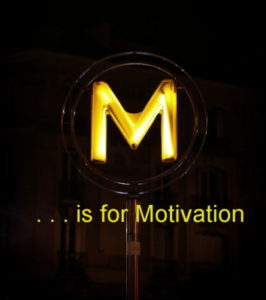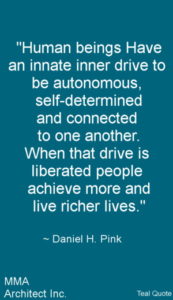MMA Architect Inc. and Windsor Ontario architect, Stuart Miller hope you enjoy our blog. We take a fresh approach to business blogging, highlighting a variety of topics.

With all the motivational posts on social media, we thought it was time to review some findings on motivation. Our research on this topic led us to the book “Drive,” by Daniel Pink.
According to Pink, there is a “mismatch between what Science knows and what business does.” We were taught that the best way to motivate ourselves and others is with external rewards, the carrot and stick approach. Pink emphasizes that carrots and sticks may have worked in the 20th century, but research has found they are not always the most effective motivators for today’s challenges. “Too many organizations, businesses, governments and non-profits operate from assumptions about human potential and individual performance that are outdated and unexamined.”
“Drive” notes that there are three types of motivational operating systems. “These sets of assumptions and protocols about how the world works and humans behave run beneath our laws, economic arrangement and business practices. Motivation 1.0 presumed that humans were biological creatures struggling for survival. Motivation 2.0 stated that humans also respond to rewards and punishments in their environments. Motivation 3.0, Harry Harlow’s 3rd Drive, emphasizes that we now need to upgrade human motivation to include a 3rd drive – to learn to create, and to better our world.”
The betterment of our world can and will occur, but it is no easy task. It will require us to solve novel problems, creating things our 21st-century world didn’t know it was missing or simply can’t live without due to sustainability issues. This is going to require a great deal of creative, self-directed thought.
For a surprisingly large number of people, jobs have become more complex, more interesting and more self-directed. Pink cites Mckinsey & Co. who estimates that 30% of job growth comes from algorithmic work, while 70% comes from heuristic work.
Heuristic work is made up of tasks for which there is no algorithm, no set formula or simple directions. This work requires experimentation with a variety of possibilities, devising novel solutions. While algorithmic work follows a set of established instructions, has a limited focus, a defined process and one conclusion. Pink goes on to explain that according to psychologist Teresa Amabile’s principle of creativity, heuristic workers are fueled by intrinsic motivation due to the creativity and novelty of their work. However, algorithmic workers following one single prescribed path to complete a task tend to still respond well to extrinsic motivators.

Pink’s “Drive” also focuses on 3 elements of motivation, autonomy, mastery and purpose. Those who are fueled by intrinsic motivators have a need to be autonomous, to direct their own lives. They learn to create new things and do better by themselves and for the world without incentives. Intrinsic motivators thrive in a state of optimal-challenge called “flow,” where their right brain, self-created “Goldilocks” tasks are not too easy and not too hard. These mid-range tasks are essential to reaching a state of “flow” and to achieving mastery.
Allowing a person creative freedom when working on a project keeps work fresh and enjoyment based. Creative tasks provide the strongest and most pervasive intrinsic motivation. The final element, purpose, is when the worker seeks a cause more enduring than themselves, e.g. Sustainability or providing the world with quality innovative technology. “Traditional businesses were profit maximizers, squaring perfectly with traditional motivational operating systems. New entities are purpose maximizers.”
Our educational systems have also caught onto the fact that we couldn’t endlessly continue to incentivize our children. Instead, we needed to provide them with more creative endeavours in their classrooms. Hence, over the last decade schools have focused even more on critical thinking skills, cooperative learning, the ability to develop a growth mindset and integrating technology throughout the curriculum. Schools continue to stress reading, writing and arithmetic but have added a fourth “r” relevance. These changes in education will hopefully better prepare students for the heuristic, right-brain tasks required by modern economies.
To find out whether you are fueled more by intrinsic or extrinsic motivators take an assessment on heuristic or algorithmic behaviours, click here, http://www.danpink.com/drive-survey/
MMA Architect Inc. and Windsor Ontario Architect, Stuart Miller, B. Arch., OAA enjoy working with Windsor-Essex, Chatham-Kent and Ontario businesses and homeowners to create efficiencies that promote business growth and improve lifestyles. MMA Architect Inc. looks forward to serving clients with a variety of quality services.
MMA Architect Inc. licensed professional architect, Windsor, Ontario aka @YQGArchitect, MMAarchBlog ~ ©MMA Architect Inc., April 3, 2018, Blog 19.
